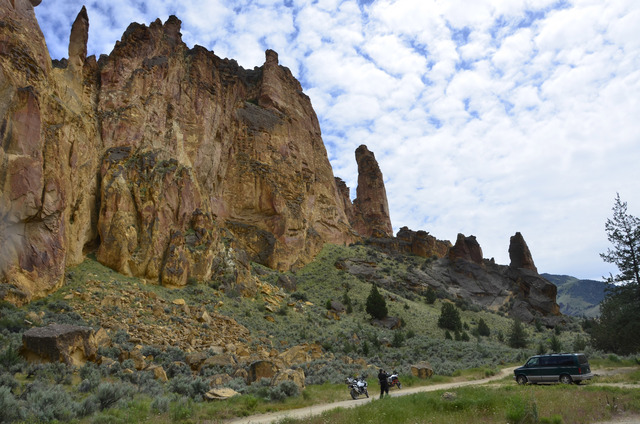Oregon’s Owyhee Canyonlands: A monumental debate over preservation, use
MALHEUR COUNTY, Ore. — Everybody with a vested interest in the Owyhee Canyonlands feels the same about the land: It’s beautiful. It’s spiritual. It’s a special place that deserves our respect. Their disagreement stems from a philosophical divide: How should we respect this wild desert along the southeast Oregon border?
Should we preserve it solely as a pristine natural wonder? Or should we utilize its natural resources to support the local community?
Both sides say they’re open to compromise - a process that has been hammered out on public lands for more than a century - but have instead found themselves embroiled in a bitter battle that dives headlong into land-use politics, and divides Oregonians into two stubborn camps.
Behind the slogans and beyond the talking points, there are people with real fears and real frustrations. Their feelings mirror a much bigger conversation about federal land management in the 21st century - recently amplified by the occupation of the Malheur wildlife refuge - but for now they’re focused on Owyhee, a vast and beautiful piece of southeast Oregon.
WHAT MAKES A MONUMENT?
As it stands, Oregon has four national monuments spread out over more than 200 square miles of land: the Oregon Caves, John Day Fossil Beds, Newberry Volcano and Cascade-Siskiyou.
The national monument designation is designed to protect historically, culturally or environmentally important areas with some flexibility. Federal land managers typically allow existing mines, timber harvests and grazing allotments to continue on monuments, but ban any new projects from starting up.
Sitting presidents hold the power to designate monuments, ever since Congress passed the 1906 Antiquities Act. Over the last century the monument designation has been used to establish national treasures like the Grand Canyon and Olympic National Park, but recently it’s come under fire from Americans who see it as a gross overreach of presidential authority.
Currently, two proposals are being considered in Oregon: the proposed 2.5-million-acre Owyhee Canyonlands National Monument, and a 65,000-acre expansion of the existing Cascade-Siskiyou National Monument, originally established by President Bill Clinton in 2000. Both would be big wins for conservationists, but big opposition stands in their way.
Nearing the end of his second term, President Obama has only three more months to decide - on these, as well as other national monument proposals - and both sides are scrambling to influence his decision.
OWYHEE UNDER THREAT
Deep canyons and sweeping prairies run for hundreds of miles along the eastern Oregon border. Golden cliffs and dark badlands dominate the desert wilderness, where the Owyhee River flows north to the Snake River.
Today, about 2 million acres of that land is run by the Bureau of Land Management, covered by a patchwork of federal protections. But is it enough? That’s the case made for the further protection of the Canyonlands, a message carried nationwide by a well-funded campaign to keep it pristine.
The campaign for the monument is run by the Oregon Natural Desert Association, a nonprofit dedicated to protecting Oregon’s high desert. The association is funded by member donations and grants from the Conservation Alliance - a group of outdoor recreation companies that includes Columbia, REI, Keen, The North Face, Patagonia and Clif Bar.
Brent Fenty, executive director of the Oregon Natural Desert Association, said the group has been fighting to protect the Owyhee Canyonlands for years, seeing the area as a vital and pristine environment under threat from mining interests, and oil and gas development.
“Unfortunately there are a whole lot of impacts or threats that we’re seeing in the recent future and that’s what we’re trying to get ahead of,” he explained. “This is not a new conversation. People have been talking about protecting the Owyhee for decades.”
There is significant mining potential in Malheur County, according to a recent report by the Oregon Department of Geological and Mineral Industries, but it’s unclear whether mining within the boundaries of the monument would be economically feasible. A spokeswoman for the department said while mining might be feasible, “the economic potential remains to be studied.”
According to department records, there are already four active mines within the proposed monument - two for industrial minerals and two for gemstones - and four more just outside it. That’s a cause for concern among environmentalists, who don’t trust the industry to leave well enough alone.
And while the oil and gas industry hasn’t drilled a well in Malheur County since 1962, landowners around the county have signed oil and gas leases over the last few years in anticipation. No new wells have been actually approved, but it’s enough to raise a big red flag for the people trying to protect the Owyhee.
“We all have to recognize these are public lands,” Fenty said. “I think we always need to be careful.”
LIVING OFF THE LAND
Human beings have inhabited the Owyhee Canyonlands since the end of the Ice Age. Hunter-gatherers came first, leaving behind petroglyphs of wooly mammoths. Over centuries, those bands coalesced into tribes: Northern Paiute, Bannock and Shoshone. White settlers came in the 1860s, setting up communities supported by cattle ranches and gold mines.
Even after the federal government moved in, the economy of Malheur County still relied heavily on the land, as ranchers worked with federal officials to graze livestock on private and public property. They’ve made their living that way for generations; it’s become their way of life.
“The communities exist here in harmony and in conjunction with natural resources,” Andrew Bentz, a third-generation rancher and the former sheriff of Malheur County, said. “Those go away, so do the communities. It’s as simple as that.”
Bentz has found himself at the center of the fight for Owyhee. In 2015, he was the spokesman of a county-appointed task force in opposition to the proposal, and now he’s the secretary for the Owyhee Basin Stewardship Coalition, the primary group fighting the monument.
He, like the others opposed, sees the designation as an unnecessary additional layer of protection, and one that doesn’t include the needs and opinions of the locals who stand to be impacted by it.
“The people that know the land the best should have some say in it,” he said. “We want the opportunity to build a better plan for the land. It’s our part of the state. We want that opportunity.”
Bentz, who also works for Bentz Solutions, a company that works with local resource extraction companies, disagrees with the notion that the land is in imminent danger. Commercial mining isn’t usually feasible in the Owyhee Canyonlands today, he argued, and no new oil wells have been drilled.
The bigger issue for his coalition, and the locals opposed, is access to grazing.
About 94 percent of Malheur County is rangeland, and of that about two-thirds is run by the Bureau of Land Management. Ranchers who run cattle there have grazing allotments with the federal government - parcels of land where each rancher is allowed to graze livestock for part of the year. The Antiquities Act allows existing allotments to be grandfathered in, but local ranchers simply don’t trust the government to honor that agreement.
“It has never worked anywhere the way they say it’s going to,” Bentz said. First comes the monument designation, “then the death of a thousand cuts begins.”
Many opponents of national monuments make this argument, pointing to Garfield County, Utah, as proof. It was there in 1996 that the massive Grand Staircase-Escalante National Monument became the first to be managed by the Bureau of Land Management. Tourism went up, but in 2015 the county declared a state of emergency, blaming the monument for a sharp decline in jobs and school enrollment.
“We do everything we can to protect our people. The problem is multiple use is gone from these lands,” county commissioner Leland Pollock told The Salt Lake Tribune at the time. “We are trying to survive.”
The Tribune reported that population had actually increased, and that unemployment had held steady since the monument designation, but as natural resource jobs disappeared, the community nonetheless became the focal point of a growing movement against federal land management - one that has become more vocal as conservationists push for another national monument at nearby Bears Ears.
The movement against federal land management has found fresh life in the armed occupation of the Malheur wildlife refuge - which is in Harney County, neighbor to the Owyhee Canyonlands’ Malheur County - but locals opposed to the Owyhee monument are quick to distance themselves from the Bundys. For them this is about their local communities, and the land their families have lived on for generations. They don’t want another occupation, they don’t want another fight.
“If a monument is declared in Malheur County, I am concerned about public safety. I am concerned about the people from outside the area who will come to our county with their own agendas,” Malheur County Sheriff Brian Wolfe said at a May hearing about the monument. “The very heart of our community is at stake.”
NO NEGOTIATIONS
There’s nothing new about this debate. It has been going on as long as settlers have pushed west, clearing forests and mining mountains on their way, a vast harvest of natural resources that inspired the American conservation movement at the end of the 19th century.
In 1910, just after President Theodore Roosevelt established the Mount Olympus National Monument (what is today Olympic National Park), Seattle-based prospector F.H. Stanard spoke out about the “brainless restrictions” that “cursed” the land. In 1940, The Oregonian wrote that a Hells Canyon National Park proposal “runs head on, like a locomotive collision, into the economics of Wallowa County.”
Our public lands exist today because of compromises between federal agencies and the people who make a living on natural resources. That’s why timber companies can log on Mount Hood, and why tribes can fish in the Columbia River Gorge.
Fenty said his organization has made repeated attempts to compromise with the ranchers and officials in Malheur County, but has been rebuffed and put off for years. Bentz pushes for an agreement that includes the voices of ranchers, but his coalition has shown little interest in negotiating.
Last November his task force presented the Malheur County Court with three options: Do nothing, organize opposition to the monument, or sit down with the coalition proposing it. The county court, a three-person commission, unanimously chose to organize opposition.
That decision resulted in a countywide vote that showed residents overwhelmingly opposed to the national monument, and kicked off the Our Land Our Voice campaign that has so far raised $500,000 to fight the proposal.
Ryan Frank, spokesman for the campaign, said it “was formed as a reactive move,” meant to hit back at the well-funded effort from the other side. At the time, with only a year before the end of President Barack Obama’s term, their best strategy was opposition, not negotiation.
“It forces you into a corner to make your best case,” Frank said of the timeline.
They’ve made good use of that time. The “No Monument” slogan, emblazoned on signs and stickers around the state, has been the most successful rallying cry on either side. Even if you know nothing about the national monument proposal, you probably know that people are opposed.
After all, the plight of rural Oregon is compelling - as the “not guilty” verdict for the Malheur refuge occupiers made clear. Even those in support of the monument can find room to respect the ranchers of Malheur County.
David Moryc, supporter and senior director of conservation group American Rivers, said it’s great to see people who are good stewards of the land. He loves the Owyhee as much as the ranchers do, and that mutual respect is still there, despite the bitter fight.
But for him and his fellow supporters, the danger to this wild and beautiful place is imminent. The threat of mining and drilling still hovers like a specter.
“The question is,” Moryc said. “Can we just keep waiting until that threat emerges until we take the steps necessary to protect this area?”
RELATED
Movement to create Utah monument leads to another Western land fight
Past transfers of federal land to Nevada led to corruption, history suggests




























